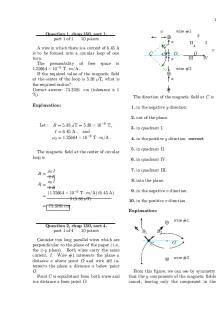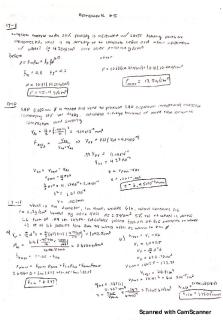HW#5 Summer 2020-1 - homework 5 PDF

| Title | HW#5 Summer 2020-1 - homework 5 |
|---|---|
| Author | Zain Adtani |
| Course | Thermodynamics I |
| Institution | The University of Texas at Arlington |
| Pages | 2 |
| File Size | 160 KB |
| File Type | |
| Total Downloads | 41 |
| Total Views | 143 |
Summary
homework 5...
Description
MAE 3310: Thermodynamics I HW#5 Summer 2020 DUE:08/04/2020
1. Air is expanded from 2000 kPa and 500°C to 100 kPa and 50°C. Assuming constant specific heats, determine the change in the specific entropy of air. 2. A piston–cylinder device contains 0.75 kg of nitrogen gas at 140 kPa and 37 °C. The gas is now compressed slowly in a polytropic process during which P𝑉 1.3 = constant. The process ends when the volume is reduced by one-half.Determine the Entropy change of Nitrogen during this process. 3. Air is compressed in an isentropic compressor from15 psia and 70°F to 200 psia. Determine the outlet temperature and the work consumed by this compressor per unit mass of air.
4. Water enters the pump of a steam power plant as saturated liquid at 20 kPa at a rate of 45 kg/s and exits at 6 MPa. Neglecting the changes in kinetic and potential energies and assuming the process to be reversible, determine the power input to the pump.
5. Helium gas is compressed from 16 psia and 85 °F to 120 psia at a rate of 10 f𝑡 3 /s. Determine the power input to the compressor, assuming the compression process to be(a) isentropic, (b) polytropic with n =1.2, (c) isothermal.
6. Steam at 4 MPa and 350 °C is expanded in an adiabatic turbine to 120 kPa. What is the isentropic efficiency of this turbine if the steam is exhausted as a saturated vapor?
7. Carbon dioxide enters an adiabatic compressor at100 kPa and 300 K at a rate of 1.8 kg/s and exits at 600 kPa and 450 K. Neglecting the kinetic energy changes, determine the isentropic efficiency of the compressor.
8. Air enters a compressor steadily at the ambient conditions of 100 kPa and 22°C and leaves at 800 kPa. Heat is lost from the compressor in the amount of 120 kJ/kg and the air experiences an entropy decrease of 0.40 kJ/kg ∙K. Using constant specific heats, determine ( a) the exit temperature of the air, (b) the work input to the compressor, and (c) the entropy generation during this process....
Similar Free PDFs

Homework-5-sln - HW5
- 4 Pages

HW5 - Written Homework
- 2 Pages

HW#5 Summer 2020-1 - homework 5
- 2 Pages

Hw5 pset - hw 5
- 2 Pages

Hw5 solutions - hw 5
- 4 Pages

AMS310 Fall 2018 HW5 - Homework
- 6 Pages

Hw5
- 1 Pages

Hw5
- 2 Pages

Homework 5
- 2 Pages

Homework 5
- 9 Pages

Homework 5
- 4 Pages

Hoework 5 - homework 5
- 3 Pages

Homework 5
- 2 Pages
Popular Institutions
- Tinajero National High School - Annex
- Politeknik Caltex Riau
- Yokohama City University
- SGT University
- University of Al-Qadisiyah
- Divine Word College of Vigan
- Techniek College Rotterdam
- Universidade de Santiago
- Universiti Teknologi MARA Cawangan Johor Kampus Pasir Gudang
- Poltekkes Kemenkes Yogyakarta
- Baguio City National High School
- Colegio san marcos
- preparatoria uno
- Centro de Bachillerato Tecnológico Industrial y de Servicios No. 107
- Dalian Maritime University
- Quang Trung Secondary School
- Colegio Tecnológico en Informática
- Corporación Regional de Educación Superior
- Grupo CEDVA
- Dar Al Uloom University
- Centro de Estudios Preuniversitarios de la Universidad Nacional de Ingeniería
- 上智大学
- Aakash International School, Nuna Majara
- San Felipe Neri Catholic School
- Kang Chiao International School - New Taipei City
- Misamis Occidental National High School
- Institución Educativa Escuela Normal Juan Ladrilleros
- Kolehiyo ng Pantukan
- Batanes State College
- Instituto Continental
- Sekolah Menengah Kejuruan Kesehatan Kaltara (Tarakan)
- Colegio de La Inmaculada Concepcion - Cebu


